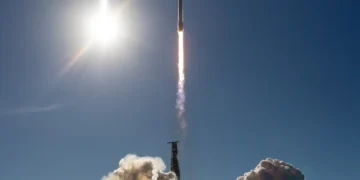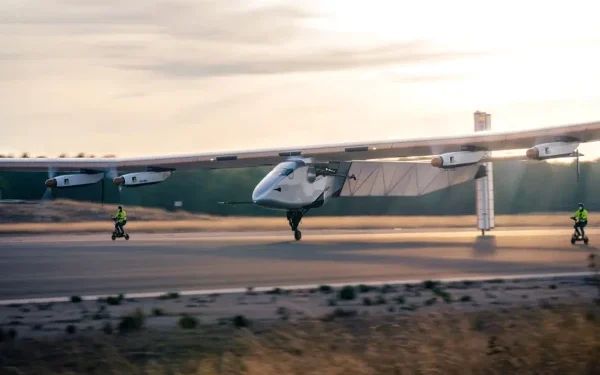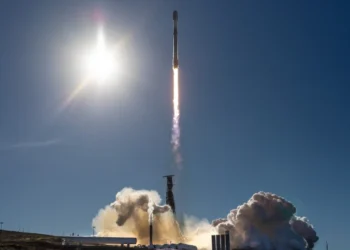Aerospace innovation takes a giant leap forward with a solar-powered, ultra-endurance spy drone developed to remain airborne for up to three months. The drone, introduced by American startup Skydweller Aero in collaboration with French defense technology giant Thales, promises to reshape surveillance, maritime security, and defense strategies around the world.
Introduction to the Next-Generation Spy Drone
A new chapter in aerospace technology has begun with the unveiling of a maritime spy drone that can stay aloft for an astonishing 90 days without landing. This breakthrough in drone endurance is the result of cutting-edge research, sustainable energy systems, and a growing demand for persistent aerial surveillance capabilities.
Developed by Skydweller Aero and Thales
The drone is the brainchild of Skydweller Aero, an American aerospace startup headquartered in Oklahoma City, with operations in Spain and Italy. The company is focused on creating long-endurance aircraft powered by renewable energy. Partnering with Thales, a global leader in aerospace, defense, and security systems, the collaboration has produced one of the most advanced solar-powered drones to date.
Design and Engineering: A Marvel of Modern Aviation
Carbon Fiber Construction for Ultra-Lightweight Performance
The drone’s impressive endurance is largely due to its carbon fiber construction, which keeps the airframe lightweight yet durable. Carbon fiber offers several advantages, including:
- High strength-to-weight ratio
- Resistance to environmental stress and corrosion
- Flexibility in aerodynamic design
These attributes are critical for an aircraft that must withstand continuous flight across variable altitudes, weather conditions, and international airspaces.
Solar-Powered Innovation
At the heart of this innovation is the drone’s solar energy system. Equipped with advanced photovoltaic cells embedded in its expansive wings, the drone harnesses energy directly from the sun. These solar panels are connected to a sophisticated battery management system, allowing it to store energy during daylight hours and operate at night without relying on traditional fuel.
This energy independence means that the drone does not need to land to refuel, enabling continuous, autonomous missions for up to 90 days.
Mission Capabilities: Persistent Surveillance and Maritime Intelligence
Ideal for Maritime and Coastal Monitoring
The drone is particularly well-suited for maritime surveillance, where persistent monitoring over vast oceanic territories is essential. Defense agencies and governments often face difficulties in keeping watch over territorial waters, shipping routes, and exclusive economic zones (EEZs). This drone addresses that gap with its ability to:
- Monitor suspicious maritime activities
- Track vessels in real time
- Detect illegal fishing or smuggling operations
- Assist in search-and-rescue missions
Applications Beyond Military Use
Although it was originally designed for defense and intelligence gathering, the drone’s capabilities extend to civilian and humanitarian missions. Possible applications include:
- Disaster response: Monitoring natural disaster zones from above to coordinate emergency relief
- Environmental monitoring: Observing deforestation, glacial retreat, marine pollution, or wildlife migrations
- Border surveillance: Offering governments a cost-effective, long-duration alternative to manned flights or satellite coverage
The Flight Tests: Aiming for the 90-Day Milestone
According to Skydweller Aero, the drone has already undergone several successful flight tests, steadily progressing toward its goal of a full 90-day flight. The aircraft’s current demonstrated endurance is close to the milestone, showcasing its capability for near-continuous operations.
These early tests confirm:
- Stability in long-duration operations
- Reliable solar energy performance
- Autonomous navigation and communication systems
The achievement of a 90-day uninterrupted flight will make this drone the longest-endurance aircraft ever built, surpassing all existing unmanned aerial vehicles (UAVs) and even piloted aircraft in flight duration.
Strategic Implications for Defense and Security
A Game-Changer for Modern Warfare and Intelligence
For defense strategists, the introduction of this drone could be a paradigm shift. Traditional surveillance methods, including manned aircraft and satellites, are expensive and constrained by fuel limitations or orbital paths. By contrast, this drone offers:
- Round-the-clock coverage
- Reduced operational costs
- Greater flexibility in deployment zones
Its ability to loiter over a target area for weeks or months enhances the effectiveness of signal intelligence (SIGINT), imagery intelligence (IMINT), and electronic surveillance operations.
NATO and Allied Interest
Given Thales’ involvement and the system’s compliance with NATO standards, it’s likely that member states within the North Atlantic Treaty Organization (NATO) and allied countries will express strong interest in acquiring or co-developing the technology. Long-term surveillance without risking pilot lives fits perfectly into modern defense doctrines focused on unmanned, risk-reducing platforms.
Environmental and Operational Advantages
A Sustainable Approach to Aerospace
One of the most remarkable aspects of this spy drone is its sustainable energy model. At a time when carbon emissions and climate change are global concerns, the drone offers a zero-emission alternative to fuel-powered surveillance planes.
- No fossil fuels required
- Minimal noise pollution
- Reduced operational footprint
This makes the drone ideal not only for defense but for use in sensitive ecological zones where traditional aircraft could cause environmental disturbances.
Cost-Efficiency and Maintenance Benefits
Operating a long-endurance drone like this reduces the frequency of takeoff and landing cycles, which are typically the most stressful and fuel-intensive phases of flight. Fewer landings also mean:
- Lower maintenance requirements
- Less wear-and-tear on landing gear and airframe
- Decreased downtime between missions
Technical Features and Specifications (Estimated)
While exact specifications are classified or proprietary, based on available information and comparable designs, the drone is believed to feature:
| Feature | Specification |
|---|---|
| Wingspan | Approximately 70–80 feet |
| Power Source | Solar panels + lithium-ion battery system |
| Airframe Material | Carbon fiber composite |
| Payload Capacity | Up to several hundred kilograms |
| Navigation System | GPS with onboard autonomous AI guidance |
| Communications | Satellite uplink/downlink + secure datalink |
| Sensors | EO/IR cameras, radar, AIS, SIGINT equipment |
| Flight Ceiling | 45,000 feet (estimated) |
| Endurance | Target: 90 days continuous |
A Glimpse into the Future of Autonomous Aerial Surveillance
Paving the Way for Solar-Powered Aviation
This drone represents more than just a leap in defense technology—it symbolizes the future of sustainable aviation. As technology matures, we can expect to see:
- Scaled-down versions for commercial applications
- Intercontinental drone networks for real-time global coverage
- Advanced AI integration for autonomous decision-making in mission-critical scenarios
A Model for Commercial and Scientific Use
Beyond defense and security, Skydweller Aero’s innovation could inspire next-generation solutions in telecommunications, weather monitoring, and internet delivery to remote areas—much like the projects previously proposed by companies such as Facebook and Google.
Conclusion
The collaboration between Skydweller Aero and Thales has resulted in a game-changing technological marvel: a solar-powered spy drone capable of flying for up to 90 continuous days. Designed with cutting-edge materials, driven by sustainable energy, and optimized for long-endurance missions, this drone has the potential to redefine aerial surveillance across multiple sectors.
As the aerospace industry continues to pursue greener, more efficient solutions, this drone stands out as a beacon of innovation, offering persistent intelligence gathering, cost-effective operations, and eco-friendly performance—all without ever needing to land.

























